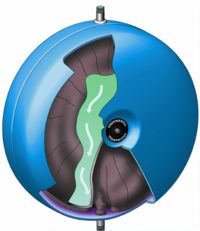Hospital avoids stagnant water in pressurised systems

The use of Pneumatex flow-through pressure vessels at Edinburgh Royal Infirmary avoids the accumulation of stagnant water.
Stagnant water in pressurised systems at the Royal Infirmary in Edinburgh is being avoided be using twin-port flow-through reservoir vessels. They are self-flushing in operation. Conventional expansion vessels have only one port and are installed via a T connection off the water supply line and could act as a dead leg. The Pneumatex vessels from Engineering Appliances have in-line connections and are continuously flushed during operation. The vessels are said to meet the HSE recommendation for ‘no unnecessary dead legs...that that system can be cleaned and disinfected’. Design issues include a substantial bore for each port. Best-practice designs have bores of 50 mm for vessels from 100 to 500 litres so as not to limit the water flow required by users. Also, the bag separating water from the air charge must have a life of many cycles because it operates at every pump start. A life of around 150 000 cycles is warranted by the best manufacturers. External indication of failure of the bag in a Pneumatex vessel is provided by a mechanical device at the base shwoing a red indicator. info@engineeringappliances.com
Related links:


